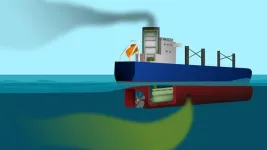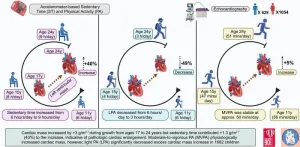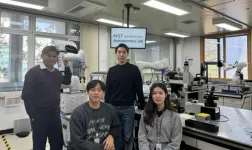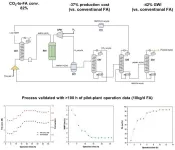(Press-News.org) Researchers at the Universities of Melbourne and Manchester have invented a breakthrough technique for manufacturing highly purified silicon that brings powerful quantum computers a big step closer.
The new technique to engineer ultra-pure silicon makes it the perfect material to make quantum computers at scale and with high accuracy, the researchers say.
Project co-supervisor Professor David Jamieson, from the University of Melbourne, said the innovation – published today in Communication Materials, a Nature journal – uses qubits of phosphorous atoms implanted into crystals of pure stable silicon and could overcome a critical barrier to quantum computing by extending the duration of notoriously fragile quantum coherence.
“Fragile quantum coherence means computing errors build up rapidly. With robust coherence provided by our new technique, quantum computers could solve in hours or minutes some problems that would take conventional or ‘classical’ computers – even supercomputers – centuries,” Professor Jamieson said.
Quantum bits or qubits* – the building blocks of quantum computers – are susceptible to tiny changes in their environment, including temperature fluctuations. Even when operated in tranquil refrigerators near absolute zero (minus 273 degrees Celsius), current quantum computers can maintain error-free coherence for only a tiny fraction of a second.
University of Manchester co-supervisor Professor Richard Curry said ultra-pure silicon allowed construction of high-performance qubit devices – a critical component required to pave the way towards scalable quantum computers.
“What we’ve been able to do is effectively create a critical ‘brick’ needed to construct a silicon-based quantum computer. It’s a crucial step to making a technology that has the potential to be transformative for humankind,” Professor Curry said.
Lead author Ravi Acharya, a joint University of Manchester/University of Melbourne Cookson Scholar, said the great advantage of silicon chip quantum computing was it used the same essential techniques that make the chips used in today’s computers.
“Electronic chips currently within an everyday computer consist of billions of transistors — these can also be used to create qubits for silicon-based quantum devices. The ability to create high quality silicon qubits has in part been limited to date by the purity of the silicon starting material used. The breakthrough purity we show here solves this problem."
Professor Jamieson said the new highly purified silicon computer chips house and protect the qubits so they can sustain quantum coherence much longer, enabling complex calculations with greatly reduced need for error correction.
“Our technique opens the path to reliable quantum computers that promise step changes across society, including in artificial intelligence, secure data and communications, vaccine and drug design, and energy use, logistics and manufacturing,” he said.
Silicon – made from beach sand – is the key material for today’s information technology industry because it is an abundant and versatile semiconductor: it can act as a conductor or an insulator of electrical current, depending on which other chemical elements are added to it.
“Others are experimenting with alternatives, but we believe silicon is the leading candidate for quantum computer chips that will enable the enduring coherence required for reliable quantum calculations,” Professor Jamieson said.
“The problem is that while naturally occurring silicon is mostly the desirable isotope silicon-28, there’s also about 4.5 percent silicon-29. Silicon-29 has an extra neutron in each atom’s nucleus that acts like a tiny rogue magnet, destroying quantum coherence and creating computing errors,” he said.
The researchers directed a focused, high-speed beam of pure silicon-28 at a silicon chip so the silicon-28 gradually replaced the silicon-29 atoms in the chip, reducing silicon-29 from 4.5 per cent to two parts per million (0.0002 per cent).
“The great news is to purify silicon to this level, we can now use a standard machine – an ion implanter – that you would find in any semiconductor fabrication lab, tuned to a specific configuration that we designed,” Professor Jamieson said.
In previously published research with the ARC Centre of Excellence for Quantum Computation and Communication Technology, the University of Melbourne set – and still holds – the world record for single-qubit coherence of 30 seconds using silicon that was less purified. 30 seconds is plenty of time to complete error-free, complex quantum calculations.
Professor Jamieson said the largest existing quantum computers had more than 1000 qubits, but errors occurred within milliseconds due to lost coherence.
“Now that we can produce extremely pure silicon-28, our next step will be to demonstrate that we can sustain quantum coherence for many qubits simultaneously. A reliable quantum computer with just 30 qubits would exceed the power of today's supercomputers for some applications,” he said.
This latest work was supported by research grants from the Australian and UK governments. Professor Jamieson’s collaboration with the University of Manchester is supported by a Royal Society Wolfson Visiting Fellowship.
A 2020 report from Australia’s CSIRO estimated that quantum computing in Australia has potential to create 10,000 jobs and $2.5 billion in annual revenue by 2040.
“Our research takes us significantly closer to realising this potential,” Professor Jamieson said.
*A qubit – such as an atomic nucleus, electron, or photon – is a quantum object when it is in a quantum superposition of multiple states. Coherence is lost when the qubit reverts to a single state and becomes a classical object like a conventional computer bit, which is only ever one or zero and never in superposition.
END
New super-pure silicon chip opens path to powerful quantum computers
2024-05-07
ELSE PRESS RELEASES FROM THIS DATE:
Millions in costs due to discharge of scrubber water into the Baltic Sea
2024-05-07
Discharge from ships with so-called scrubbers cause great damage to the Baltic Sea. A new study from Chalmers University of Technology, Sweden, shows that these emissions caused pollution corresponding to socio-economic costs of more than EUR 680 million between 2014 and 2022. At the same time, the researchers note that the shipping companies' investments in the much-discussed technology, where exhaust gases are "washed" and discharged into the sea, have already been recouped for most of the ships. This means that the industry is now making billions ...
Bio-inspired materials’ potential for efficient mass transfer boosted by a new twist on a century-old theory
2024-05-07
The natural vein structure found within leaves – which has inspired the structural design of porous materials that can maximise mass transfer – could unlock improvements in energy storage, catalysis, and sensing thanks to a new twist on a century-old biophysical law.
An international team of researchers, led by the NanoEngineering Group at the Cambridge Graphene Centre, has developed a new materials theory based on ‘Murray’s Law’, applicable to a wide range of next-generation functional ...
Small pump for kids awaiting heart transplant shows promise in Stanford Medicine-led trial
2024-05-07
A small, implantable cardiac pump that could help children await heart transplants at home, not in the hospital, has performed well in the first stage of human testing.
The pump, a new type of ventricular assist device, or VAD, is surgically attached to the heart to augment its blood-pumping action in individuals with heart failure, allowing time to find a donor heart. The new pump could close an important gap in heart transplant care for children.
In a feasibility trial of seven children who received the new pump to support their failing hearts, six ultimately underwent heart transplants ...
Time flies, but your hands tell: Haut.AI cracks the age code with hand analysis
2024-05-07
Tallinn, Estonia – 7th May 2024, 10 AM CET – Haut.AI, a leader in responsible skincare artificial intelligence (AI) development, today announced a breakthrough research paper demonstrating the effectiveness of using hand images for accurate age prediction. This innovative approach offers a viable alternative to traditional facial photo methods and promotes fairer AI solutions.
The study, titled “Predicting human chronological age via AI analysis of dorsal hand versus facial images: A study in a cohort of Indian females,” shows that AI models trained on hand images achieve comparable accuracy to those using facial images, with an average error of ...
Babraham Institute receives £48M strategic investment from BBSRC for a four-year programme of work to promote lifelong health
2024-05-07
Following a quinquennial review by the Biotechnology and Biological Sciences Research Council (BBSRC), the Babraham Institute will receive £48m for the period 2024-2028 to advance research on the mechanisms that maintain the health of our cells, tissues and organs across the life course.
This work is key in driving BBSRC’s strategic research priorities around an integrated understanding of health, developing and applying transformative technologies and advancing our understanding of the rules of life.
As one of eight UK bioscience ...
Childhood sedentariness linked to premature heart damage – light physical activity reversed the risk
2024-05-07
An increase in sedentary time from childhood caused progressing heart enlargement, a new study shows. However, light physical activity could reduce the risk. The study was conducted in collaboration between the Universities of Bristol and Exeter, and the University of Eastern Finland, and the results were published in the prestigious European Journal of Preventive Cardiology.
Left ventricular hypetrophy refers to an excessive increase in heart mass and size. In adults, it is known to increase the risk for heart attacks, stroke, and premature death.
In the present study, 1,682 children ...
Parents’ watchful eye may keep young teens from trying alcohol, drugs: Study
2024-05-07
PISCATAWAY, NJ – Teenagers are less likely to drink, smoke or use drugs when their parents keep tabs on their activities--but not necessarily because kids are more likely to be punished for substance use, suggests a new study in the Journal of Studies on Alcohol and Drugs.
Researchers found that, contrary to common belief, parents’ “monitoring” does not seem to boost the odds of catching their kids using substances. However, when kids simply are aware that their parents are monitoring behavior, they avoid trying alcohol or drugs in the first place.
It is the fear of being caught, rather than actually being punished.
Many studies ...
A triumph of galaxies in three new images from the VST
2024-05-07
FOR IMMEDIATE RELEASE
Distant, far away galaxies. Interacting galaxies, whose shape has been forged by the mutual gravitational influence, but also galaxies forming groups and clusters, kept together by gravity. They are the protagonists of three new images released by the VLT Survey Telescope (VST).
VST is an optical telescope with a 2,6 diameter mirror, entirely built in Italy, that has been operating since 2011 at the European Southern Observatory’s (ESO) Paranal Observatory in Chile. Since 2022, the telescope has been fully managed by INAF through the National Coordination Centre for VST, ...
Smart labs for bespoke synthesis of nanomaterials are emerging
2024-05-07
In the early 20th century, the development of a catalyst for ammonia synthesis by the Haber-Bosch method took more than 10,000 experiments before it was successful. The development of new materials is a time-consuming and costly process from design to commercialization. However, in recent years, researchers have been working to shorten the development period by using artificial intelligence (AI). When combined with robots, it is possible to conduct material development research 24 hours a day, 365 days a year without human ...
The commercialization of CO2 utilization technology to produce formic acid is imminent
2024-05-07
CCU (Carbon Capture & Utilization), which captures CO2 and converts it into useful compounds, is crucial for rapidly transitioning to a carbon-neutral society. While CCS (Carbon Capture & Storage), which only involves CO2 storage, has entered the initial commercialization stage due to its relatively simple process and low operational costs, CCU has only been explored at the research level due to the complexity of conversion processes and high production costs of compounds.
Dr. Lee Ung's team at the Clean Energy Research Center ...







